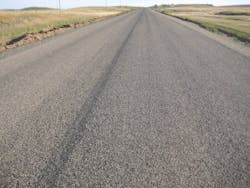Billings County, N.D., finds a solution for troubled Gas Plant Road
Gas Plant Road is an 11-mile-long, 28-ft-wide road in Billings County, N.D. This roadway is populated by several farmsteads and ranches. The traffic has significantly increased with the addition of the gas plant and the Bakken oil field production.
This section was a high maintenance road. It was continually bladed and rebladed as necessary and had a severe dust problem. With the increased traffic it was losing gravel at a higher rate than the average rate of gravel loss.
The road was in need of regraveling, so instead of using the standard regraveling practice that would not change the maintenance and dust problems, Billings County District No. 1 Road Foreman Jim Haag, with the assistance of Kadrmas, Lee & Jackson Inc., an engineering firm from Dickinson N.D., looked for an alternative cost-effective solution.
They concluded the best solution was to add a base stabilizer into the top 4 in. of the base material and apply a double chip seal surface treatment.
The existing 7 in. of material was scarified into a windrow. The road was then widened from 28 ft to 34 ft for possible paving in the future. The existing material was then re-layed. Four inches of new material was brought in and stabilized with Team Lab Chemical Corp.’s Base One.
Fine grading of the treated aggregate base could not be completed without sufficient moisture. The stabilizing chemical definitely improved the stability and strength of the aggregate base, as demonstrated by the ability of the aggregate to resist rutting and potholing.
The double chip seal was then applied. MC70 was used for the prime coat. The base layer seal coat of CRS2 was applied, and 5/8 chips and 3/8 chips were used on the driving surface layer.
With the added strength and stability of the stabilizer and the new surface treatment, all current problems were corrected. Future maintenance would be much less involved and less costly. All the benefits of a bituminous overlay would be achieved eliminating the dust problem and retaining the existing base gravel. Future maintenance costs will be approximately the same as they would be for a bituminous paved roadway.
The reconstructed roadway has been in use for almost one full season and is performing well.
